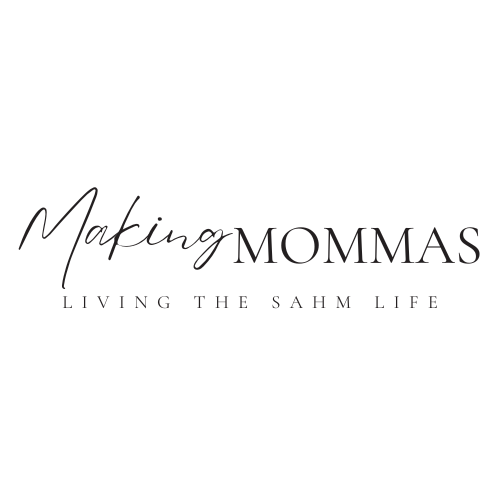In this article:
ToggleHey, there momma! I know being a stay-at-home mom is no cakewalk. It’s constant chaos, right?
Juggling laundry, cleaning, cooking, and most importantly, caring for those little ones. But what if there was a way to bring a bit of order to the madness?

Did you know that structured schedules and activities are associated with positive cognitive, social, and emotional outcomes in children? That’s why I set my stay at home mom schedule up just like a preschool schedule!
It totally changed the way I managed my days at home, and it was so easy to do! I’ll show you how.
Main Points

Adopting the structure of a preschool schedule can truly transform your day, making it more predictable and enjoyable for both you and your child.
Here are some essential elements to consider when creating your stay-at-home mom (SAHM) schedule:
- Morning Routine: Start your day with a consistent morning routine. This might include getting dressed, having breakfast, and maybe a morning walk. It sets a positive tone for the day.
- Learning Time: Dedicate a time slot for focused learning activities. This doesn’t have to be strictly academic; it can include puzzles, reading together, or arts and crafts. The goal is to make learning fun and engaging.
- Active Play: Children need to move their bodies, so ensure there are opportunities for active play. This could be time spent in the backyard, at a local park, or a structured physical activity at home.
- Quiet Time: Not just for naps, quiet time can also be for independent play or listening to stories. It’s an excellent way for children (and you!) to recharge during the day.
- Scheduled Meals and Snacks: Having set times for meals and snacks helps regulate your child’s hunger cues and ensures they’re well-fed throughout the day.
- Free Play: Allow time in the schedule for unstructured play. This is when children use their imagination and creativity without direct adult intervention.
Remember, while it’s great to have this structure, flexibility is key. Some days might not go as planned, and that’s perfectly fine.
The objective is to create a rhythm that supports your family’s needs, offering a blend of guided activities and free time that fosters growth and independence.
Building Your Preschool-like Schedule
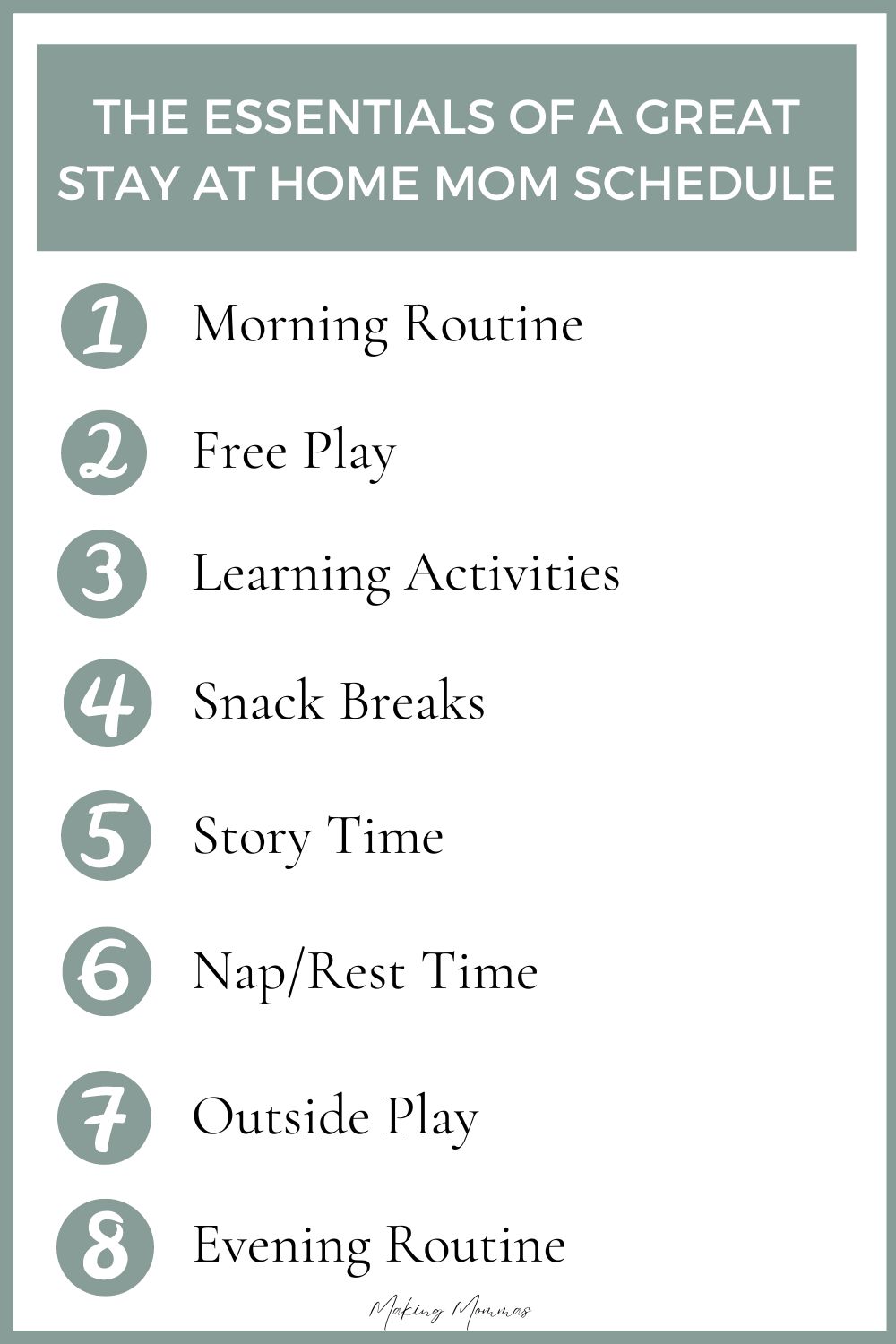
So, what does a typical preschool or daycare schedule look like? Well, let’s break it down, shall we?
Here are the key elements that shape a typical preschool or daycare day:
- The morning routine starts with a warm welcome and free play for kids to settle in and enjoy activities
- Circle time with interactive storytelling, singing, or calendar activities
- Snack break to recharge
- Guided activities, such as projects like science experiments or art projects, related to a theme
- Lunch break and rest or nap time
- Physical activity like outdoor play, yoga, or movement games
- Wind-down activity or free play before saying goodbye
Preschool days are packed with learning, play, rest, and fun. And it’s so easy to create days just like that at home.
Preschools create well-rounded daily schedules by understanding developmental needs, balancing activities, and maintaining routines. They consider age-appropriate learning, play, and rest times.
It’s a purposeful schedule designed for all-round development while ensuring the kids have a blast!
I used to work in a preschool classroom as a para. I’ll show you on how to do it. 😉
A Step by Step Guide to Setting Up Your Daily Routine Just Like a Preschool
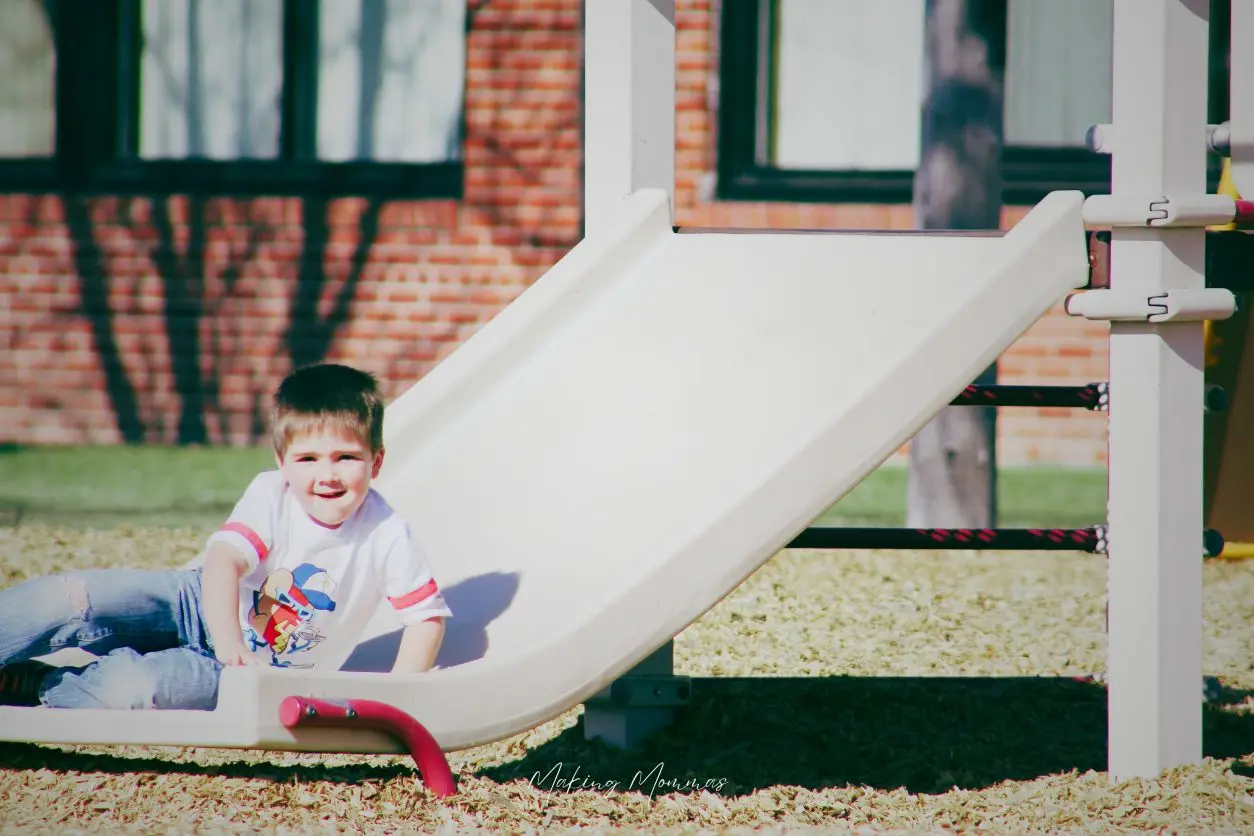
Alrighty, ready to jump in? Let’s get our hands dirty and create that perfect preschool-like daily routine for your little superheroes at home!
This can work for two to five years old. If you have an infant, you may want to create a separate stay at mom schedule for your baby.
Don’t worry, it’s not as intimidating as it may sound. Follow this step-by-step guide and you’ll be on your way to creating a fun-filled, educational day just like the pros!
Let’s get started, shall we?
1. Utilize Natural Transitions

Natural transitions are those seamless moments in our day that effortlessly move us from one activity to another.
For example, waking up naturally leads to enjoying breakfast, and finishing lunch naturally leads to naptime.
By incorporating these organic transitions into your structured schedule, you can create a smoother flow to your day and help your children adapt to their routines more easily.
But why are these transitions so important?
Because they provide a sense of predictability, structure, and continuity, which helps children understand the concept of time and order. As kids start to anticipate what comes next, it reduces anxiety and resistance.
So, how can we effectively use natural transitions at home?
It all starts with observation and incorporating the natural rhythm of your child’s day into the schedule.
For instance, after meals, you can schedule quiet activities that allow your child to digest and wind down. After naptime, you can plan more energetic activities when your kids are likely to be refreshed and reenergized.
One effective way to organize your day is by breaking it into smaller, manageable chunks based on these natural transitions. It may sound complex, but it’s actually quite simple.
Just imagine each part of the day – morning, afternoon, and evening – as a mini routine within your main daily routine.
Let’s talk about mini routines next. 😉
2. Incorporate Mini Routines
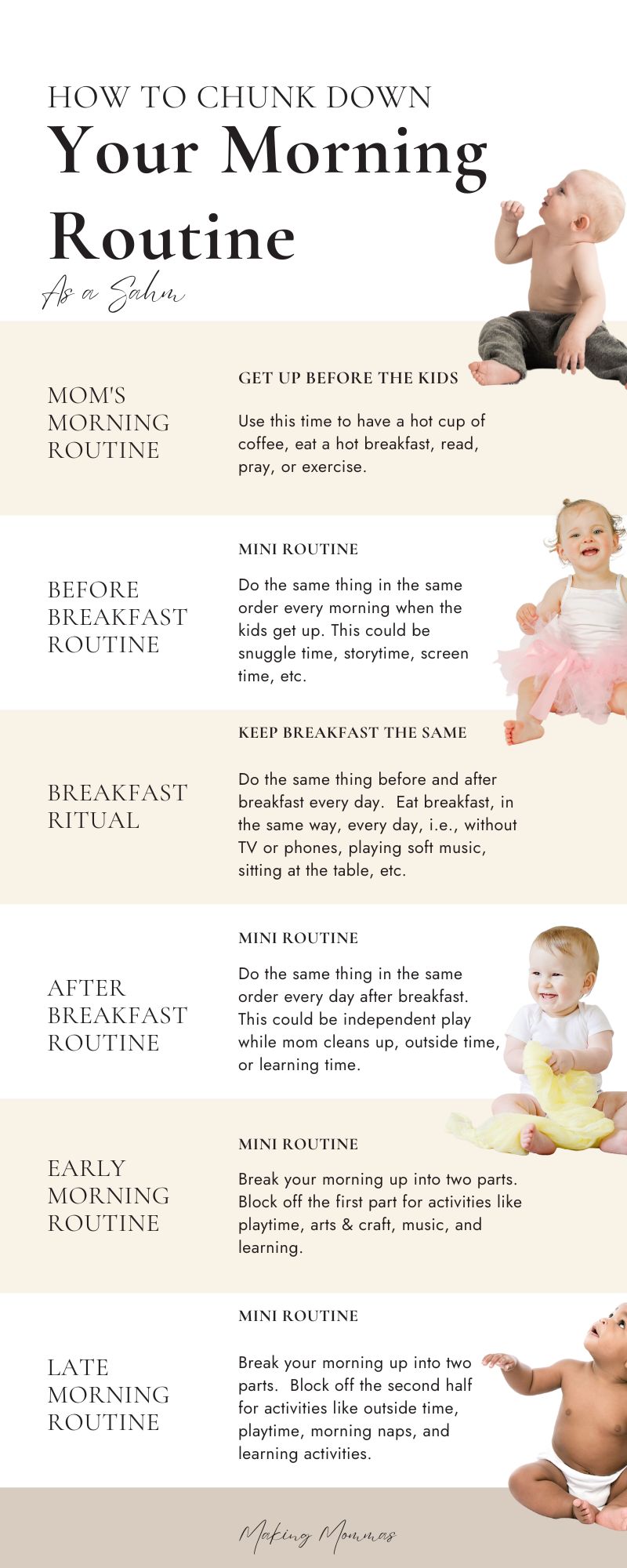
Mini routines are smaller segments of your broader daily schedule, structured around specific parts of the day or specific activities – or, in our case, your transition points.
For instance, you might have a morning routine, another for after-school time, and another to wind down before bed.
These mini routines are important for several reasons.
One, they provide an extra layer of predictability and structure within your daily schedule, making the day even easier for kids to navigate.
And two, they can help break down potentially overwhelming routines into manageable chunks, making tasks seem less daunting and more achievable. This can significantly reduce any resistance or anxiety around these activities.
Implementing mini routines at home is all about understanding your child’s needs and preferences, and then structuring activities in a way that flows seamlessly.
For instance, a morning routine could include waking up, brushing teeth, having breakfast, and getting dressed.
An after-school mini routine could involve having a snack, doing homework, and then enjoying some free play.
A bedtime mini routine might include a bath, reading a story, and then lights out.
By consistently following these mini routines, your child will know what to expect at different times of the day, helping them feel secure and confident in their environment.
Remember to be flexible and adjust these routines as needed, to ensure they serve their purpose of making your daily life simpler and more harmonious.
3. Add in Rituals

Unlike routines, rituals create meaningful experiences that bring people together. They represent traditions that hold emotional significance for the family, adding magic, fun, and warmth to the day.
They foster belonging, create shared memories, and strengthen family bonds.
Rituals offer continuity and comfort, serving as touchstones to return to. Simple activities like bedtime stories, movie nights, or preparing meals together can become rituals.
To create rituals, identify activities that resonate with family values and bring joy.
It’s about quality over quantity, focusing on the emotion and connection they evoke. Start small, let rituals evolve naturally, and be open to change.
Because they will change as your child grows.
The goal is to enrich family life and create a happier, nurturing home.
4. Incorporate Educational Activities Through Play
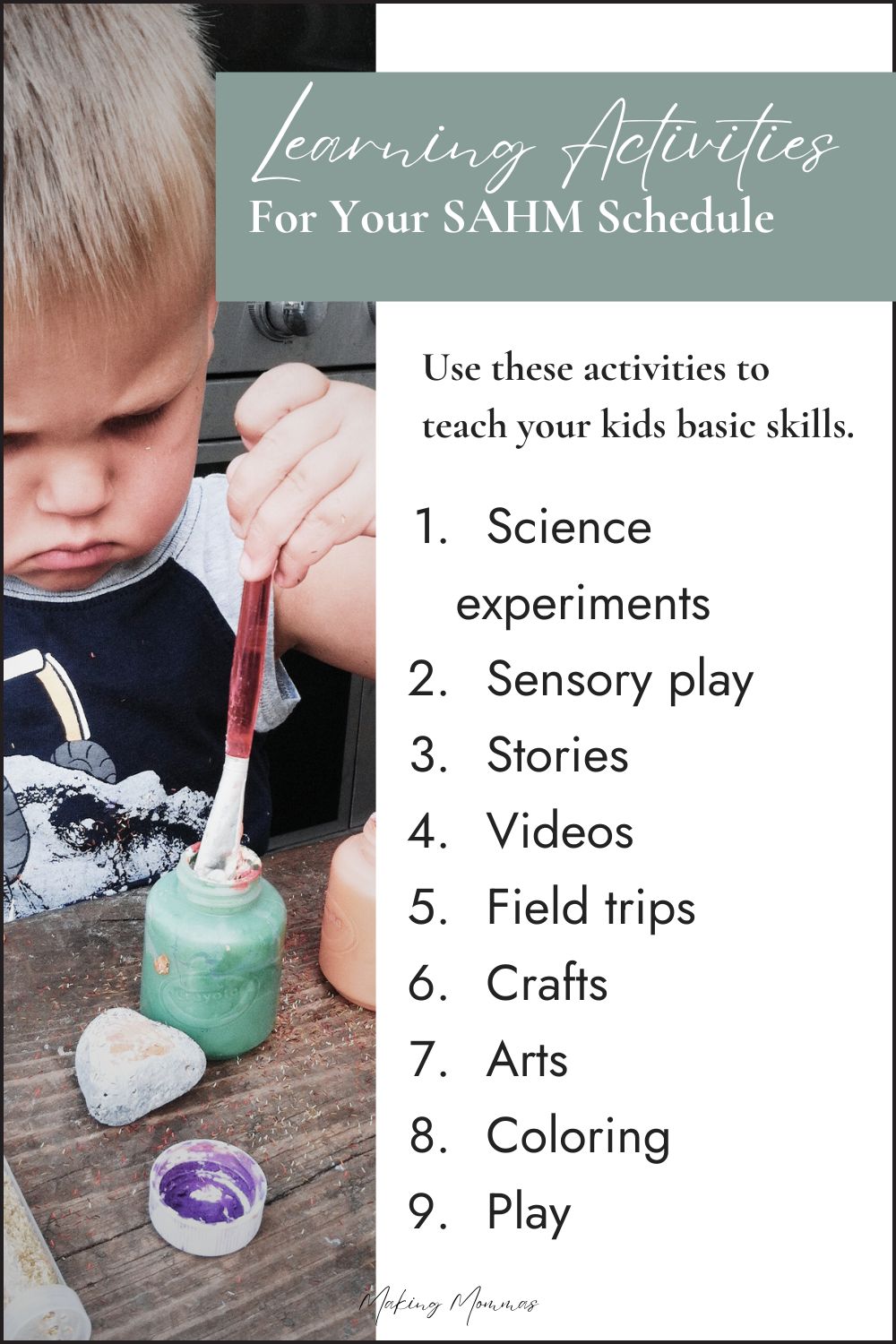
Educational activities aren’t just for preschools or daycares!
They offer a fun and engaging platform for children to explore, learn, and grow.
By blending entertainment with education, kids can develop key skills while having a great time. These activities play a huge role in shaping children’s development, stimulating curiosity, creativity, problem-solving skills, and promoting cognitive, physical, and social growth.
In fact, one study found that playing can be like a mini life training session for your kids! They also provide a practical context for learning, making abstract concepts more concrete.
Bringing educational activities into the home is not as hard as it may sound, either. Make learning a fun and natural part of daily life by identifying your child’s interests and building activities around them.
Utilize playtime as a learning tool and create educational projects, activities, and games around specific themes. For example, if it’s January, read books about snow, do crafts related to the snow, and go outside and play in the snow.
That’s really all you have to do!
Setting Up Your Own Daily Stay at Home Mom Schedule

Alright, let’s move on to setting up that stay at home mom schedule!
Planning your day can seem daunting, but don’t worry, you’ve got this!
Start by breaking your day down into chunks – morning, midday, afternoon, and evening.
This makes the day feel more manageable and less overwhelming.
Think about the natural transitions in your day. These could be things like meal times, nap times, or your work schedule.
Next, slot in mini routines into these chunks.
Maybe your morning routine consists of breakfast and a little bit of reading.
Midday could be for some outdoor play and lunch.
Afternoon might be a good time for a nap or some quiet time, and then in the evening, you can wind down with dinner and a bedtime ritual.
Once you’ve got that skeleton schedule, add in any appointments or obligations you have. This could be things like doctor’s appointments, virtual meetings, or deadlines for work.
Now comes the fun part – filling in the rest of the time with play and learning activities!
And voila! You’ve got yourself a fantastic stay at home mom schedule that even the preschool teacher would be proud of!
Remember, this isn’t set in stone. You can (and should!) adjust it as needed. The goal here is to create a flexible structure that works for your family.
So, grab that planner and start scheduling! You’re on your way to creating a fun, educational environment for your kiddos momma.
Sample Stay-at-Home Mom Schedules
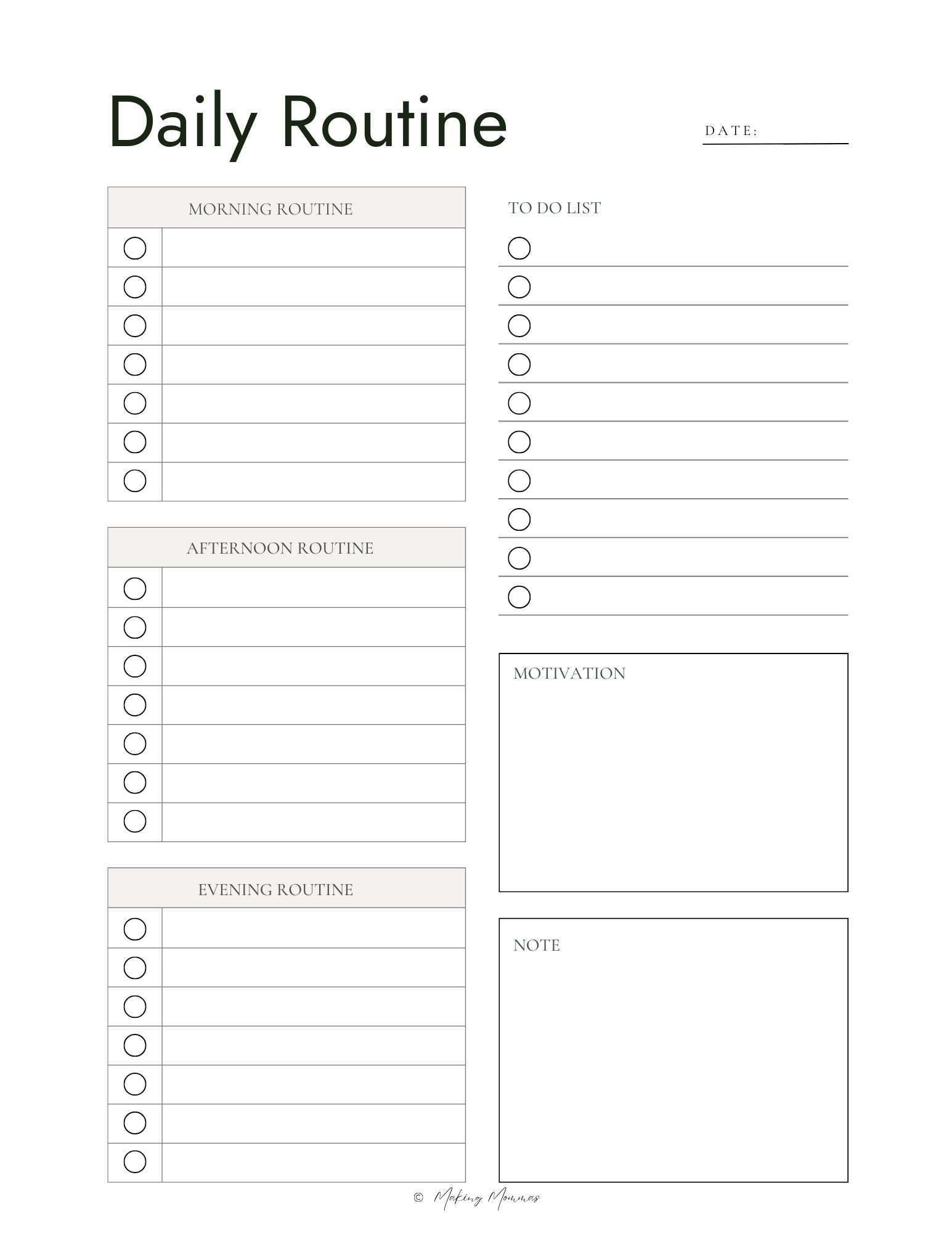
Let’s dive into a couple of examples of how you could structure your day as a stay-at-home mom:
Early Riser Stay at Home Mom Schedule
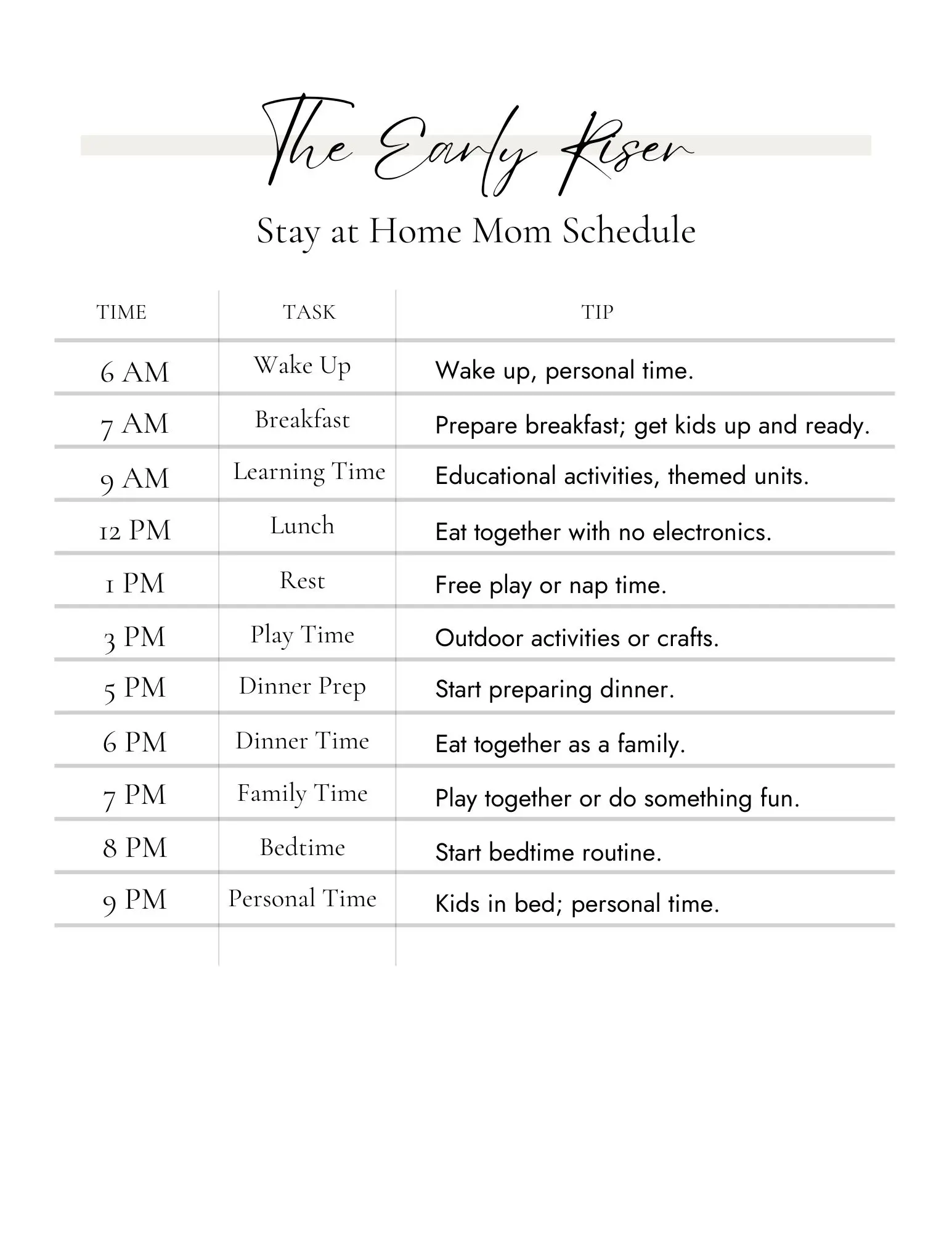
- 6:00 AM: Wake up, personal time
- 7:00 AM: Prepare breakfast, get children up and ready
- 8:00 AM: Breakfast time
- 9:00 AM: Schoolwork or educational activities
- 12:00 PM: Lunch
- 1:00 PM: Free play or nap time
- 3:00 PM: Outdoor activities or crafts
- 5:00 PM: Start preparing dinner
- 6:00 PM: Dinner time
- 7:00 PM: Family time
- 8:00 PM: Start bedtime routine
- 9:00 PM: Kids in bed, personal time
Night Owl Stay at Home Mom Schedule
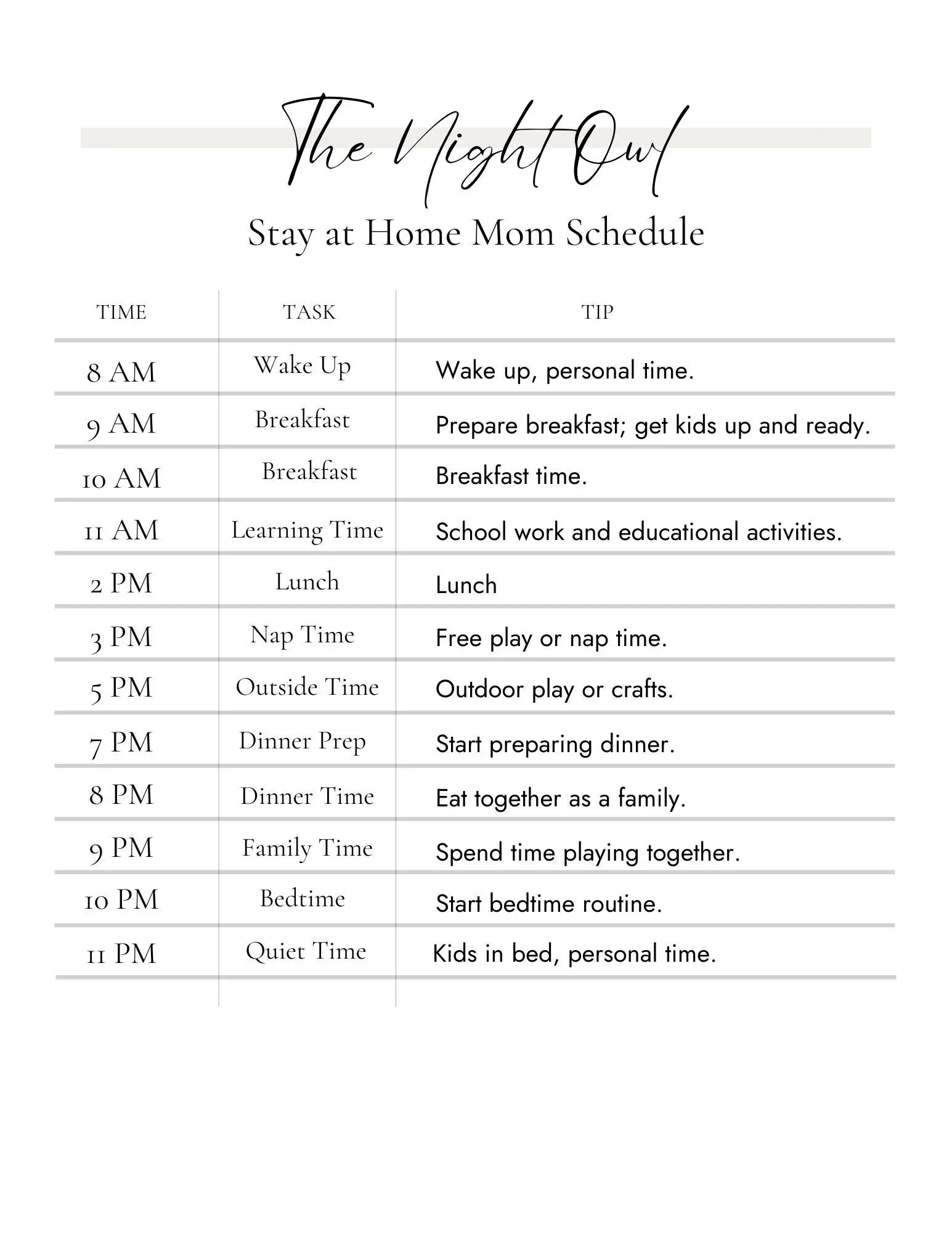
- 8:00 AM: Wake up, personal time
- 9:00 AM: Prepare breakfast, get children up and ready
- 10:00 AM: Breakfast time
- 11:00 AM: Schoolwork or educational activities
- 2:00 PM: Lunch
- 3:00 PM: Free play or nap time
- 5:00 PM: Outdoor activities or crafts
- 7:00 PM: Start preparing dinner
- 8:00 PM: Dinner time
- 9:00 PM: Family time
- 10:00 PM: Start bedtime routine
- 11:00 PM: Kids in bed, personal time
Work-From-Home Mom Schedule

- 6:00 AM: Wake up, personal time, catch up on emails
- 7:00 AM: Prepare breakfast, get children up and ready
- 8:00 AM: Breakfast time
- 9:00 AM: Set kids up with a task, start work
- 12:00 PM: Lunch
- 1:00 PM: Free play for kids, continue work
- 3:00 PM: Break from work, spend time with kids
- 5:00 PM: End work day, start preparing dinner
- 6:00 PM: Dinner time
- 7:00 PM: Family time
- 8:00 PM: Start bedtime routine
- 9:00 PM: Kids in bed, personal time, wrap up work if needed
Community-Engaged Mom Schedule
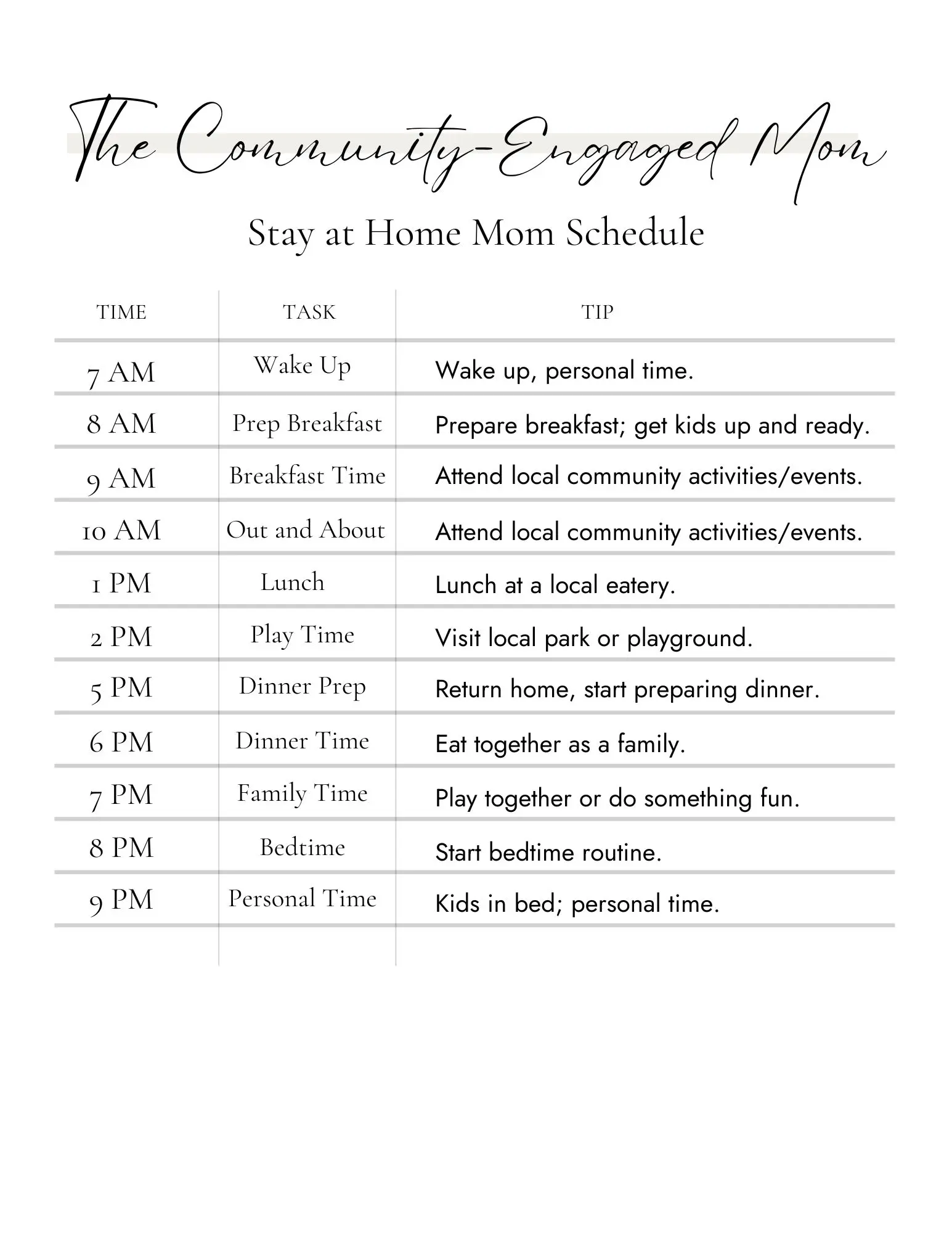
- 7:00 AM: Wake up, personal time
- 8:00 AM: Prepare breakfast, get children up and ready
- 9:00 AM: Breakfast time
- 10:00 AM: Attend local community activities/events
- 1:00 PM: Lunch at a local eatery
- 2:00 PM: Visit local park or playground
- 5:00 PM: Return home, start preparing dinner
- 6:00 PM: Dinner time
- 7:00 PM: Family time
- 8:00 PM: Start bedtime routine
- 9:00 PM: Kids in bed, personal time
Play-Inclined Stay at Home Mom Schedule
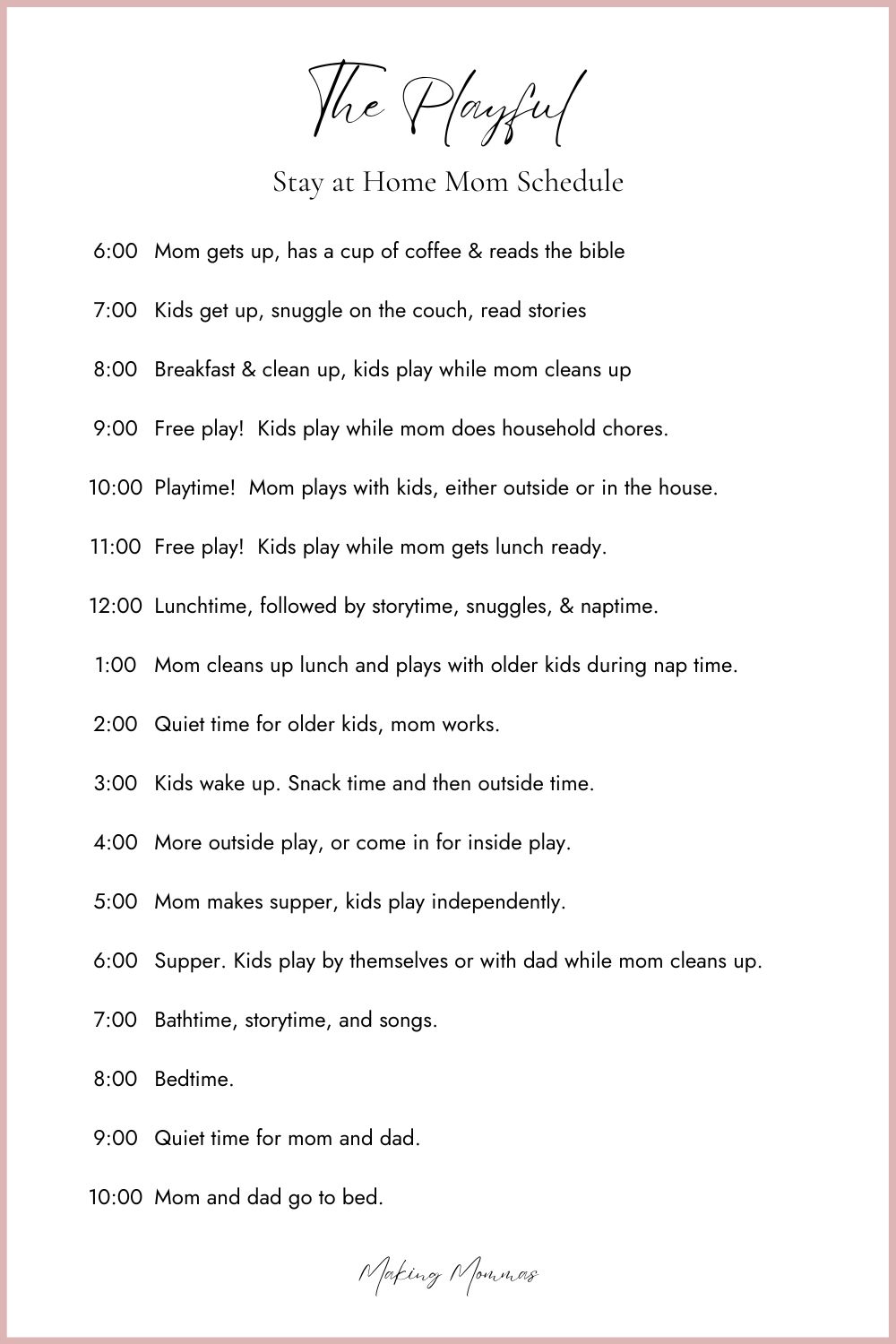
- 7:00 AM: Wake up, personal time
- 8:00 AM: Prepare breakfast, get children up and ready
- 9:00 AM: Breakfast time
- 10:00 AM: Start with educational play activities
- 12:00 PM: Lunch
- 1:00 PM: Storytime followed by nap
- 3:00 PM: Outdoor play or indoor crafts
- 5:00 PM: Start preparing dinner
- 6:00 PM: Dinner time
- 7:00 PM: Family game night
- 8:00 PM: Start bedtime routine
- 9:00 PM: Kids in bed, personal time
Homeschooling Mom Schedule
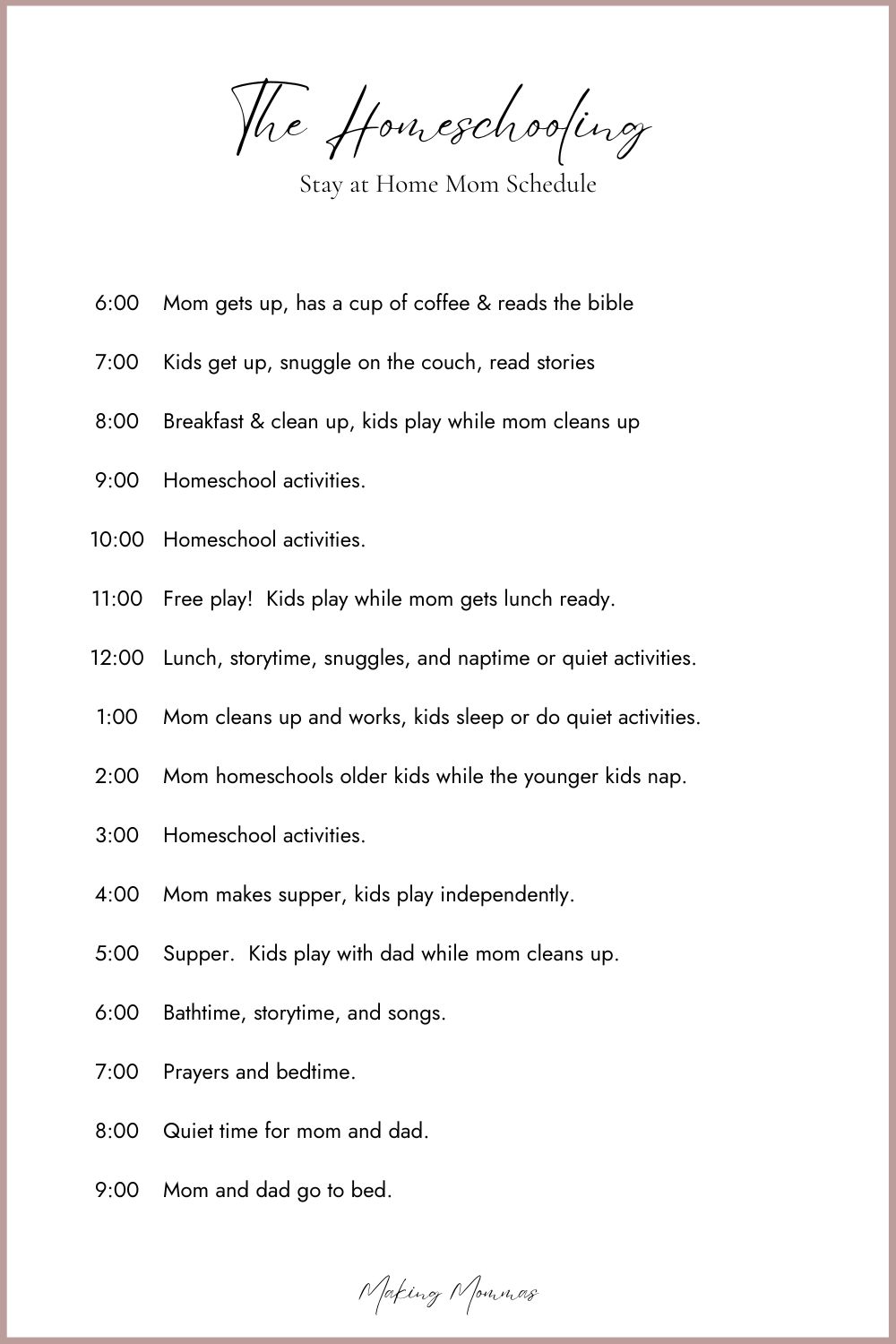
- 6:00 AM: Wake up, personal time, prep for the day
- 7:00 AM: Prepare breakfast, get children up and ready
- 8:00 AM: Breakfast time
- 9:00 AM: Start homeschooling sessions (Math, Science)
- 12:00 PM: Lunch
- 1:00 PM: Continue homeschooling sessions (Language, Social Studies)
- 3:00 PM: Break for recreational activities or field trips
- 5:00 PM: Review of the day’s lessons, start preparing dinner
- 6:00 PM: Dinner time
- 7:00 PM: Family time
- 8:00 PM: Start bedtime routine
- 9:00 PM: Kids in bed, personal time, plan next day’s lessons
Remember, these are just examples!
You need to create your own schedule, that works for your family.
Knowing your family’s values can make it so much easier, too.
For instance, if you prioritize educational pursuits, your timetable might reflect more homeschooling or learning activities. On the other hand, if your family cherishes outdoor adventures, then integrating nature walks or park visits could be a core part of your plan.
I value play as a form of learning and building strong family bonds, so my stay at home mom schedule always has a lot of individual play time and structured play time.
Recognizing your values will help you to create a stay at home mom schedule that’s not only practical but also nurtures the emotional and intellectual growth of the entire family.
The key is to have a general routine that provides structure, while still allowing flexibility, spontaneity and fun!
Free Stay at Home Mom Schedule Template!!

So, are you ready to get your day super organized and bring some balance to your life?
I’ve got a fantastic free printable stay-at-home mom schedule just for you! You can even customize it to suit your needs.
This schedule is a game-changer and will help you manage your day with ease.
Click the button below to download your free template and start making the most of your days!
Remember, the magic lies in planning and flexibility.
Embrace the chaos, plan your day, and watch the magic unfold!
Frequently Asked Questions

Alright, I know you’ve got some questions bubbling up in your mind right now. Curiosity is a good thing, momma!
So, let’s dive into some of the frequently asked questions about this super handy stay-at-home mom schedule.
How should a stay-at-home mom set a schedule?

You can easily create a daily schedule by identifying key activities for the day: meals, nap times, play, and learning.
Allocate specific times for each activity, aiming for consistency while allowing flexibility.
Remember, the schedule provides a framework, not restrictions. Aim for a balanced day that meets your child’s needs and allows time for personal activities and rest.
It’s okay if every day doesn’t go perfectly according to the schedule. Life happens, and the schedule is there to guide, not dictate.
What do stay-at-home moms do all day?

What don’t they do!
As a stay at home mom, you’ll have a busy schedule, filled with caring for children, household chores, managing finances, and shopping.
It’s important to find personal time for self-care, like reading, exercising, or pursuing hobbies.
Every mom’s day is unique, but they all involve a delicate balancing act between family and personal needs.
How do stay-at-home moms survive?

I run!
No, seriously, though. Surviving as a stay-at-home mom requires flexibility, patience, and self-care, momma!
While a consistent routine helps with organizing daily activities, being adaptable is most important, especially for unexpected changes in children’s needs.
Patience is equally important, as days can be challenging, messy, and exhausting.
Remember, it’s okay to have a bad day and not complete everything on your to-do list.
And don’t forget self-care – taking time for personal activities like reading, hobbies, or a quick nap helps manage stress and maintain wellbeing.
Stay connected with friends, seek support when needed, and cherish rewarding moments amidst the chaos. It’s a tough job, momma, but also filled with immeasurable love and joy.
How do stay-at-home moms make daily routines?

What’s worked best for me is prioritizing tasks, setting a flexible schedule, and involving the kids when possible.
Start the day with a plan, including meals, educational activities, playtime, chores, and personal time.
A visual schedule helps older kids understand the day’s flow. And remember to include breaks for the both the kids and you.
And don’t forget to involve children in age-appropriate chores to keep them engaged and lighten your load!
Don’t stress about perfection; some days go as planned, others don’t, and that’s okay.
How do I make a daily schedule for a stay-at-home mom?

As a stay-at-home mom, creating a daily schedule begins with identifying and prioritizing tasks.
Start by allocating time for your kids’ activities, meals, and educational tasks.
Next, tackle chores and personal to-dos.
Remember to include breaks for you and your children. Stay flexible to handle any unexpected situations.
Use planners or digital apps to track your routine. And involve your children in chores to teach responsibility and lighten your load.
Remember, schedules are guidelines, not rigid structures. It’s okay if things don’t go as planned every day.
At the End of the Day…

Modeling my day after a preschool schedule was a game changer for me! It brought structure, balance, and joy to our days at home.
With a structured routine for play, learning, meals, and rest, we could flow through our day with a sense of purpose and fulfillment. And the benefits were immediately clear; my kids thrived on the predictability and variety, which in turn gave me blocks of time to focus on household tasks – and work on my blog!
We discovered the importance of cherishing both our moments together and our time apart, nurturing independence in my children while simultaneously enhancing my own wellbeing.
This method didn’t just organize our day – it enriched our lives, reminding me that within the framework of routine lies the freedom to explore, learn, and grow together. 💕
You’ve got this, momma!
More on Sahm Schedules
A Step by Step Guide to Creating Your Sahm Schedule
The Secret to a Great Stay-At-Home Mom Schedule
